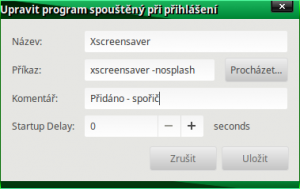

- #Xscreensaver linux how to#
- #Xscreensaver linux install#
- #Xscreensaver linux manual#
- #Xscreensaver linux password#
Xdefaults file,Īnd then tell the running xscreensaver process to restart itself, like so: It wakes up, then you will need to reload your. Xscreensaver to notice your changes immediately instead of the next time If you change a setting in your X resource database, or if you want (The file willīe reloaded the next time the screen saver needs to take some action, such asīlanking or unblanking the screen, or picking a new graphics mode.) Is already running, it will notice this, and reload the file. xscreensaver file, you would write the following: Xdefaults file for example, to set the timeout parameter xscreensaver file exists, it overrides any settings xscreensaver file in your home directory or in the X resourceĭatabase. Options to xscreensaver are stored in one of two places: inĪ. Like customize xscreensaver for site-wide use or something.
#Xscreensaver linux manual#
In this manual unless you are trying to do something tricky, Note - in previous versions of Ubuntu you could have used a screensaver called glslideshow - however this doesnt appear to work in 11.10. You shouldn't need to know any of the stuff described The easy way to configure xscreensaver is to run the Manual page describes lower level ways of changing settings. Program, and change the settings through the GUI. The easiest way to configure xscreensaver is to simply run the The xscreensaver program is a daemon that runs in the background Note that xscreensaver has a client-server model: Program pops up a dialog box that lets you configure the screen saver,Īnd experiment with the various display modes. It also provides configuration and control of your monitor's power-saving Though its default mode of operation is merely to display pretty pictures on This program can lock your terminal in order to prevent others from using it, Turns off as soon as there is any mouse or keyboard activity. Idle for a period, and then runs a graphics demo chosen at random. The xscreensaver program waits until the keyboard and mouse have been You can follow the same steps as in GNOME 3 desktop.Xscreensaver - extensible screen saver and screen locking framework To disable screen lock, simply change the setting in ~/.xscreensaver. You can also edit this file manually to adjust screen lock settings, without going through GUI. Once you change screensaver preferences via GUI like above, it will create ~/.xscreensaver, which is a screensaver preference file. In this settings, you can change screensaver activation time and screen lock delay, as well as enable/disable screen lock. To disable screen lock, simply change the following setting in ~/.kde/share/config/kscreensaverrc. Once the file is edited, the change will automatically take effect immediately. To adjust screen lock settings from the command line, you can edit ~/.kde/share/config/kscreensaverrc.
#Xscreensaver linux password#
After 300 seconds from that point on, screen lock will be activated, requiring password authentication. In this example, screensaver will be launched after 15 minutes of inactivity. Also, you can enable or disable screen locking. Here, you can change screen inactivity period and screen lock delay. Go to System Settings -> Display and Monitor.
#Xscreensaver linux install#
To install dconf-editor on Fedora: $ sudo yum install dconf-editor To install dconf-editor on Debian, Ubuntu or Linux Mint: $ sudo apt-get install dconf-tools To disable screen lock: $ dconf write /org/gnome/desktop/screensaver/lock-enabled falseĪlternatively, you can use dconf-editor, a GUI-frontend for dconf command. To activate screensaver and lock the screen after 10 minutes: $ dconf write /org/gnome/desktop/session/idle-delay 600
#Xscreensaver linux how to#
If you want to control screen lock from the command line, here is how to do it. In this setting, you can set screen inactivity period and screen lock delay. Go to System Settings -> Brightness and Lock. In this tutorial, I am going to show how to configure screen lock settings in various Linux desktop environments. Also, in case you want prevent your screen from going off and locked down for an extended period of time (e.g., when watching a movie), you probably want to disable screen lock feature. You may want to adjust these settings based on your typical work environment.

The default screensaver is typically configurable, and you can change settings like inactivity period or screen lock delay. How to adjust screen lock settings on Linux desktopĮvery major Linux desktop nowadays comes with a screensaver program by default (e.g., xscreensaver), which then can be used to lock the screen for security purposes.


 0 kommentar(er)
0 kommentar(er)
